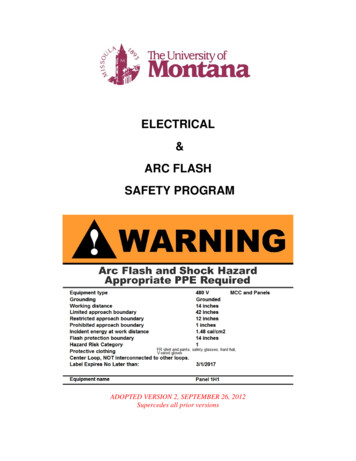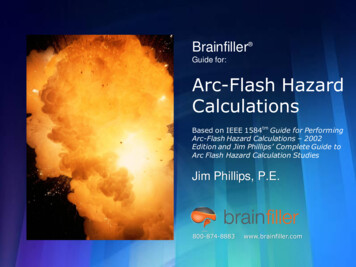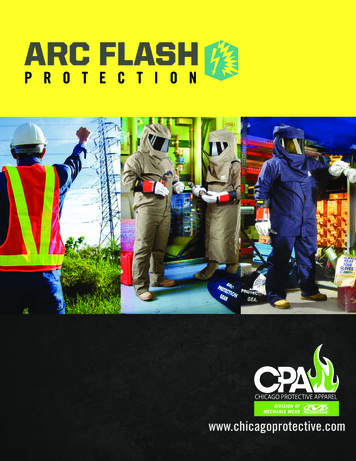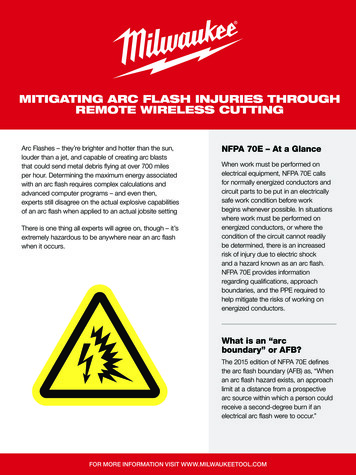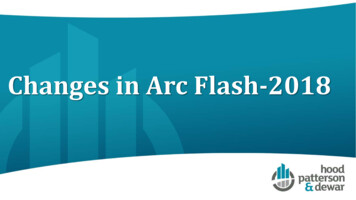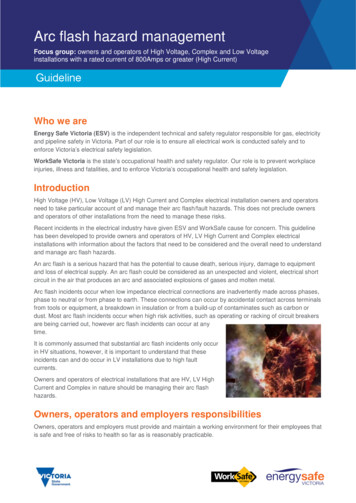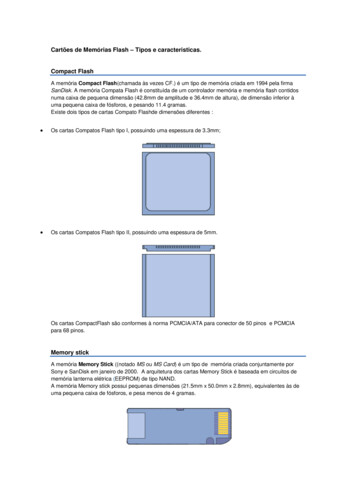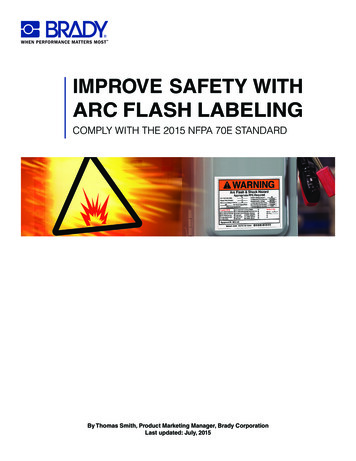
Transcription
IMPROVE SAFETY WITHARC FLASH LABELINGCOMPLY WITH THE 2015 NFPA 70E STANDARDBy Thomas Smith, Product Marketing Manager, Brady CorporationLast updated: July, 2015
COMPLY WITH NEW 2015 NFPA 70E STANDARDS, INCREASE SAFETY AND SAVE COSTS WITH PROPER ARC FLASH LABELINGThe Occupational Safety and Health Administration (OSHA) is citing and fining employers for failure to protect employeesfrom the dangers of arc flash. For guidelines on how to protect employees, OSHA refers employers to the NFPA 70Estandard, “Standard For Electrical Safety In the Workplace.”This document provides information on the most current arc flash labeling requirements, as well as best practices forcreating and maintaining such labels. In the 2015 version of the NFPA 70E standard, arc flash labeling requirements arecovered under Article 130.5(D) and 130.7(E)(1). Additional labeling requirements are also included in Article 110.16 of the2014 version of the National Electric Code (NEC). This whitepaper will provide guidance for complying with both standards.What Needs to be Labeled?Arc flash labeling is the responsibility of the employer, not the manufacturer or installer of the equipment. The NECprovides the following examples of electrical equipment that must be field marked with a warning label (This is not an allinclusive list): Switchboards Industrial control panels Panel boards Motor control centers Meter socket enclosuresLabeling is required for any piece of electrical equipment that is likely to require examination, adjustment, service ormaintenance while energized, creating the potential for an arc flash incident to occur. Thus, many employers are alsolabeling bus ducts and other electrical equipment not specifically called out in the NEC.Any modifications or renovations to electrical equipment that will change data on the label will require an updated arc flashrisk assessment and label according to the 2015 NFPA 70E standard. At minimum, the safety program needs to be auditedat intervals not to exceed 3 years and arc flash risk assessment shall be periodically reviewed at intervals not to exceed5 years. The labeling requirements for equipment installed prior to the 2002 NEC Provision are not specifically stated.However, OSHA’s general duty clause for hazard warning may apply here. Should the equipment be modified or upgradedin any way, then a label must be affixed. In fact, an OSHA representative has stated that even changing a fuse or circuitbreaker could be considered a modification that would require labeling. Labels applied prior to September 30, 2011 areacceptable if they contain the available incident energy or required level of PPE.From a safety perspective, the hazard is the same regardless of when the equipment was installed. Consequently, mostemployers are simply labeling all the appropriate equipment, regardless of when it was installed.The NEC requirement states that the marking must be in a location that is clearly visible to qualified persons before theybegin work. Typically, the label is placed outside the panel or enclosure door. In some cases, companies choose to put thelabel inside the door to protect it from harsh environments; however, this should only be done if the door must be opened(allowing the label to be seen) in order to remove the panel face or enclosure. The key point is that the label should beeasily noticeable by workers before they may be exposed to any potentially dangerous live parts.What Needs to Appear on the Label?Article 110.16 in the NEC states that relevant electrical equipment shall be “field marked to warn qualified persons ofpotential electric arc flash hazards.”In Article 130.7(E)(1), the NFPA 70E standard further notes that the design and formatting of the labels should conformwith ANSI Z535 Series of Standards For Safety Signs & Tags. Thus it is recommended that the header, messageand pictogram, if used, be formatted according to ANSI standards. Currently there is not a widely-accepted symbolfor indicating an arc flash hazard. Brady offers stock arc flash labels both with and without a symbol, employing apictogram composed of a red explosive graphic inside of a triangular border for this purpose. Neither the NFPA 70E northe NEC requirements specify whether to use a “Danger” or “Warning” header; however, NFPA 70E does recommendidentifying those situations in which there is a hazard to the worker. A commonly used guideline is to use a red “Danger”header when the voltage is over 600 volts or when the incident energy is over 40 cals/cm2. Many employers have alsoPage 2www.BradyID.com/arcflash1-888-272-3946 2015 Brady Worldwide, Inc. All Rights Reserved.
COMPLY WITH NEW 2015 NFPA 70E STANDARDS, INCREASE SAFETY AND SAVE COSTS WITH PROPER ARC FLASH LABELINGstandardized to using the “Danger” signal word to indicate a situation where serious injury or death WILL occur. If it is lessthan that threshold, an orange “Warning” header is used. The employer has the final decision on which words appear onthe labels, but it is imperative that consistency be maintained on all the labels throughout the facility.It is also important to note that arc flash labels must be able to withstand their usage environment. This means that theprint should not fade and the adhesive should be aggressive enough to avoid peeling. When necessary, an overlaminateshould be applied to protect the printed surface from harsh chemicals and exposure to sunlight.Once an arc flash risk assessment has been conducted, in which the arc flash boundary, the incident energy at theworking distance and the personal protective equipment required has been determined, Article 130.5 (C) in the 2015edition of NFPA 70E further dictates that the label must contain these important elements:1. N ominal System VoltageA value assigned to a circuit or system for the purpose of conveniently designating its voltage class (e.g. 120/240 volts,480/277 volts, 600 volts).2. A rc Flash BoundaryThe distance at which an electrical arc can flash outward, which may endanger employees working on electricalequipment, where up to 2nd degree burns are likely to occur.Among key changes from 2012 standards, the Prohibited Approach Boundary hasbeen deleted. No additional protective equipment was required when crossingthe prohibited boundary after the LIMITED and RESTRICTED boundaries werepreviously implemented, therefore this delineation was removed. Also the hazard/risk category 0 has been deleted because because the new PPE table onlyspecifies for work within the arc flash boundary.Additional Boundary Requirements:Conductive Articles of Jewelry and Clothing - Watchbands, bracelets, rings,key chains, necklaces, metal frame glasses, etc. shall not be worn within therestricted approach boundary.Working Space - Shall not be used for storage. Space shall be kept clear topermit safe operation and maintenance.Barricades - When the arc flash boundary is greater than the limited approachboundary, barricades shall not be placed closer than the arc flash boundary.Note: Depending on the application thearc flash boundaries may extend to theother side of the wall.Insulated Tools - Employees shall use insulated tools when working inside therestricted approach boundary of exposed energized electrical conductors.3. At least one of the following:a. Available incident energy and the corresponding working distance (An incidental energy analysis is used tohelp predict the incident energy of an arc flash for a specified set of conditions. Incident energy is the amountof energy impressed on a surface, a certain distance away from the source, generated during an electrical arcevent. This should be measured and labeled in cal/cm2). Or the arc flash PPE category in Table 130.7(C)(15)(A)(b) or 130.7(C)(B) for equipment. But not both.ORb. Minimum arc rating of clothing (This also should be expressed in cal/cm2. Arc rated clothing indicates it hasbeen tested for exposure to an electrical arc. This was formally expressed as flame resistant in previous NFPAeditions).ORc. Site specific level of PPE.Page 3www.BradyID.com/arcflash1-888-272-3946 2015 Brady Worldwide, Inc. All Rights Reserved.
COMPLY WITH NEW 2015 NFPA 70E STANDARDS, INCREASE SAFETY AND SAVE COSTS WITH PROPER ARC FLASH LABELINGFinally, some safety-conscious employers go one step further by including shock hazardinformation on the label. After all, as long as you are going through the trouble to warnemployees of arc flash hazards, why not provide similar safety guidance for the otherelectrical hazard – shock? These labels provide complete arc flash hazard information, plusshock hazard information on the applicable voltage, approach boundaries, and insulatedglove and tool requirements.Brady Write-On LabelsBrady provides several versions of stock arc flash labels, which can be written on using apermanent pen or marker. The labels shown at the right meet all current NEC and NFPA70E requirements, including the updated 2015 version, and are available with either“Danger” or “Warning” headers.These labels include write-in fields for indicating the arc flash boundary incident energyand corresponding working distance, nominal system voltage, arc rating of clothing, PPEhazard category and check boxes for designating the required PPE. This type of extensivelabel provides employees with the most complete information for protecting themselves from arc flash hazards.Labels With Pre-Printed Arc Flash PPE Category and PPE ListsBrady also offers pre-printed arc flash labels with the arc flash PPE category and a list of the required PPE, relieving theemployer from having to hand-write this information. As with the check box labels, a version for both arc flash and shockhazards is available.Make-it-Yourself Arc Flash LabelsLarge facilities may need to create hundreds - if not thousands - of customized arc flash labels. In this case, Brady’sindustrial printing systems are the ideal solution. This option avoids the time and trouble associated with handwriting manylabels and it allows labels to be printed in batches as the project transitions from one area of the plant to another.Brady’s printer options for creating arc flash labels include the IP Thermal TransferPrinter, the PR Plus Printer, BBP 31, BBP 33 and BBP 85 Sign and Label printers.Brady label materials are designed for industrial, smooth or rough surfaces andoutdoor use and employ thermal-transfer printing to provide the optimum in UV,chemical and abrasion resistance. For single color printers, label materials with apre-printed colored ANSI “Danger” or “Warning” header are available; this allowsusers to print only the black text while still creating a color label that meets theANSIZ535 standard for safety signs and labels. If you want to print multiple colors,Brady has printer models with that capability as well, where the printer will producethe entire multi-color label on a white label stock.In addition, MarkWare and LabelMark software applications include preformatted arc flashtemplates that allow users to quickly fill in the blanks on their PC, then send the file to aBrady printer to print. The templates can also be easily customized to include a logo or othercompany-specific information.When large quantities of labels need to be created and managed, users often prefer to storethe label information in a spreadsheet. Brady software allows this data to be downloaded andautomatically merged into the label creation software for output to the Brady printer.Page 4www.BradyID.com/arcflash1-888-272-3946 2015 Brady Worldwide, Inc. All Rights Reserved.
COMPLY WITH NEW 2015 NFPA 70E STANDARDS, INCREASE SAFETY AND SAVE COSTS WITH PROPER ARC FLASH LABELINGFinally, many companies have begun using commercial power management software from companies such as SKM,EasyPower and ETAP to assist in mapping out their electrical system and creating one-line diagrams. In recent years,many of these third-party applications have added arc flash analysis modules which use the one-line information tocalculate incident energy values, flash protection boundaries and other pertinent arc flash variables.Brady software and printing systems can also be used throughout the plant for other forms of safety and facilityidentification, such as pipe marking, equipment identification, chemical labels, barcode labels and inventory labels. Thisprovides an even greater and faster return on your system investment, since it can have ongoing, beneficial use for avariety of purposes long after the primary arc flash labeling project is complete.Your Opportunity to Reduce the RiskWith the rising frequency of reported arc flash accidents, and thepotential for serious injury or death, arc flash deserves the concernit is generating within OSHA and the safety industry.To increase safety and ensure compliance throughout theworkplace, it is essential to learn and identify arc flash hazards inyour facilities. Train your employees in safe work practices and utilizethe labels and awareness aids that are available to you to keep themessage in the forefront of your workers’ minds, and reinforce thedesired behavior in your own facility.Brady can help you achieve these goals with industry-leadingproducts, training resources, services and more. For moreinformation on arc flash label solutions, go towww.BradyID.com/arcflash. Or call 1-888-272-3946 to arrangefor a Brady salesperson to visit your site.Page 5www.BradyID.com/arcflash1-888-272-3946 2015 Brady Worldwide, Inc. All Rights Reserved.
ARC FLASH LABELING COMPLY WITH THE 2015 NFPA 70E STANDARD. COMPLY WITH NEW 25 NFPA E STANARS INCREASE SAFETY AN SAVE COSTS WITH PROPER ARC FLASH LABELING 25 Ba We I A Rg Reee . In the 2015 version of the NFPA 70E standard, arc flash labeling requirements are covered under Article 130.5(D) and 130.7(E)(1). Additional labeling requirements are .
